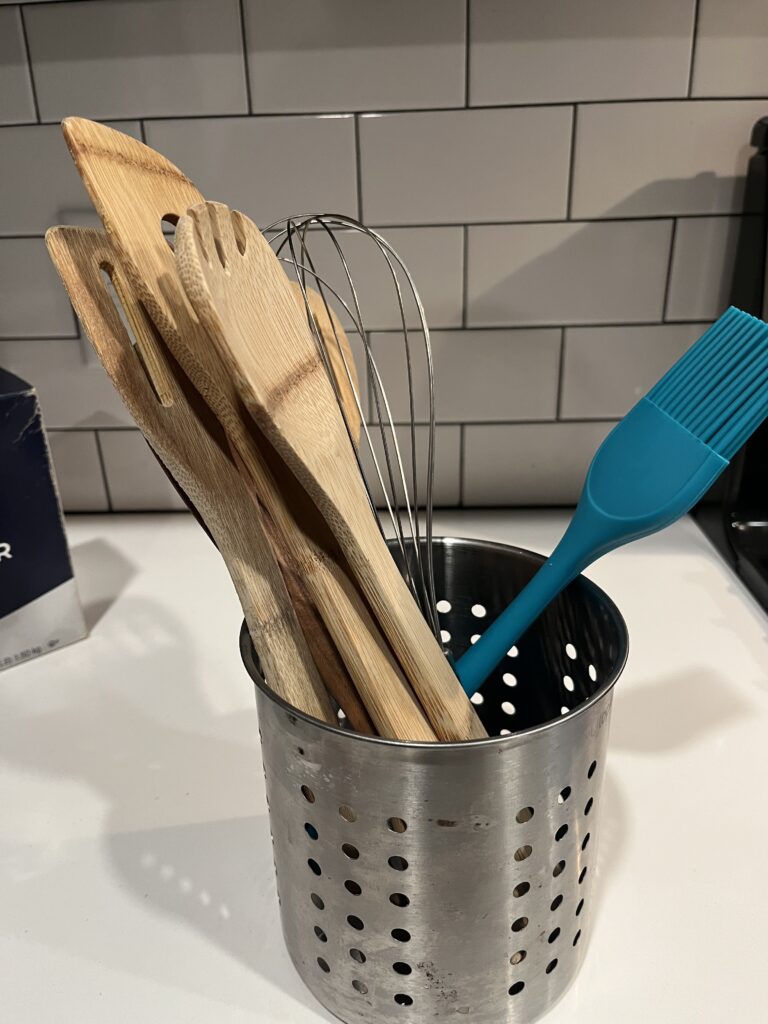When it comes to creating healthy meals, we often focus on ingredients while overlooking what we’re actually cooking with. Those convenient non-stick pans and plastic utensils might be making our lives easier, but they could also be introducing unwanted chemicals into our food.
We’ve recently replaced our non-stick pans and various cooking tools to ensure we use the safest options for our families. From metal, to bamboo and silicone alternatives, there’s a whole world of non-toxic cooking utensils that perform beautifully without the health concerns. The best part? Many of these safer options actually last longer and improve your cooking results.
Why Non-Toxic Cooking Utensils Matter for Your Health
Cooking utensils interact directly with our food, transferring substances that eventually make their way into our bodies. Many kitchen tools contain chemicals that leach into meals during food preparation, especially when exposed to heat. These toxins accumulate in our systems over time, potentially contributing to various health issues.
Hidden Dangers in Common Kitchen Tools
Standard non-stick cookware often contains PFAS (per- and polyfluoroalkyl substances), which break down at high temperatures and release harmful compounds. Plastic utensils may contain BPA, phthalates, and other endocrine disruptors that interfere with hormone function.
Here’s an article in the New York Times talking about the black plastic utensils and the risks involved with them.
Even some metal utensils contain lead, cadmium, or other heavy metals that contaminate food during the cooking process.
Health Impacts of Toxic Utensils
Cooking with toxic utensils exposes families to chemicals linked to serious health conditions. Regular exposure to these substances correlates with increased risk of thyroid problems, fertility issues, and certain cancers. Children face even greater vulnerability to these toxins due to their developing bodies and higher metabolic rates. Making the switch to non-toxic alternatives eliminates these unnecessary health risks from daily meals.
Benefits of Choosing Chemical-Free Alternatives
Non-toxic utensils provide peace of mind while offering superior cooking performance. Bamboo and wood utensils don’t scratch delicate cookware surfaces and naturally resist bacteria. High-quality silicone tools withstand temperatures up to 600°F without releasing harmful chemicals. Stainless steel utensils offer durability and dishwasher safety without the concerns of cheaper metal alternatives. These plastic-free options create a healthier cooking environment and typically last years longer than their toxic counterparts.
Common Toxic Materials in Traditional Cooking Tools
Many standard kitchen tools contain harmful substances that leach into food during cooking. These toxins pose serious health risks when they migrate from utensils to meals, especially at high temperatures.
Hidden Dangers of Teflon and PFOA
Teflon-coated pans contain perfluorooctanoic acid (PFOA) and other per- and polyfluoroalkyl substances (PFAS) that release toxic fumes when heated above 464°F. These chemicals persist in the body for years and are linked to thyroid disease, immune system disruption, and certain cancers. Scratched non-stick surfaces pose even greater risks as particles can flake off into food.
Fortunately, chemical-free alternatives like cast iron, stainless steel, and ceramic cookware provide non-toxic, durable options. We’ve found bamboo and wooden utensils excellent for protecting non-stick surfaces while avoiding harmful chemicals altogether.
Risks Associated with Certain Metals
Some metal cookware introduces health hazards through leaching. Aluminum pots and pans release metal ions into food, particularly when cooking acidic ingredients like tomatoes or citrus. Research associates aluminum exposure with neurological concerns and potential immune system effects.
Copper cookware without proper lining can leach metals that accumulate in the liver and cause digestive issues. Even some lower-quality stainless steel contains nickel and chromium that may migrate into food when cooking.
Instead, opt for high-quality stainless steel, properly seasoned cast iron, or food-grade silicone utensils. These non-toxic alternatives perform exceptionally well without the health risks. Wood and bamboo utensils offer plastic-free, renewable options that won’t scratch pans or leach harmful substances into your meals.
Best Non-Toxic Cooking Utensil Materials
When choosing non-toxic cooking utensils, the material makes all the difference in keeping harmful chemicals out of your food. We’ve researched the safest, most effective materials that combine durability with peace of mind for your kitchen arsenal.
Stainless Steel: Benefits and Limitations
Stainless steel is a top choice for non-toxic cooking utensils. It’s durable, doesn’t release chemicals into food, and withstands high temperatures. Chefs prefer stainless steel tools like spatulas, tongs, and whisks for their heat resistance and long lifespan, often lasting for decades.
However, there are some drawbacks. Stainless steel can get hot during use, and lower-quality options may contain nickel, which could affect sensitive individuals. For most home cooks, high-quality 18/10 stainless steel is a great chemical-free, dishwasher-safe option.
Silicone: When It’s Safe and When It’s Not
Food-grade silicone utensils are a safe, heat-resistant option compared to plastic. They can handle temperatures up to 600°F without releasing toxins. Their soft nature is great for protecting non-scratch cookware.
However, not all silicone is equal. Low-quality silicone may have fillers that can leach into food when heated. To check for pure silicone, twist or pinch it; if it turns white, fillers are likely present. For the safest option, choose medical-grade or platinum-cured silicone that is FDA or European-certified. Avoid cheap silicone utensils that have strong chemical smells or unusual flexibility.
These Silicone utensils from Our Place are a great option!
Wood and Bamboo Options
Wood and bamboo cooking tools offer truly organic, plastic-free alternatives that have served kitchens for centuries. Bamboo spoons, spatulas, and cutting boards contain natural antimicrobial properties that inhibit bacterial growth. Unlike metal, wooden utensils won’t scratch delicate cookware surfaces or react with acidic foods like tomato sauces.
Bamboo stands out for its sustainability—it grows rapidly without pesticides and regenerates from its own roots. Hardwoods like maple, beech, and olive wood create beautiful, long-lasting utensils when properly cared for. To maintain these natural tools, hand wash with mild soap, dry thoroughly, and occasionally treat with food-grade mineral oil or beeswax. Avoid soaking wooden utensils or putting them in the dishwasher, as prolonged moisture causes cracking and encourages bacterial growth.
Below is our humble setup of wood, bamboo, metal and silicone utensils.

Glass and Ceramic Alternatives
Glass and ceramic offer completely inert cooking options that don’t interact with food at any temperature. Glass measuring cups, mixing bowls, and storage containers provide transparent, stain-resistant alternatives to plastic. High-quality borosilicate glass withstands temperature changes without shattering, making it ideal for both hot and cold applications.
Ceramic utensil rests, serving spoons, and ladles bring both functionality and beauty to the kitchen. The non-porous surface resists bacteria and doesn’t absorb food odors or flavors. When shopping for ceramic utensils, verify they’re made with food-safe glazes free from lead and cadmium. Look for products certified by recognized testing agencies. While more fragile than metal or silicone options, properly cared for glass and ceramic tools can remain family staples for generations, combining non-toxic performance with timeless appeal.
How to Care for Your Non-Toxic Utensils
Proper maintenance of your chemical-free kitchen tools isn’t just about cleanliness—it’s about preserving their safety and extending their usability. Non-toxic utensils made from materials like bamboo, silicone, and stainless steel require specific care approaches to maintain their integrity and keep them performing at their best.
Cleaning and Maintenance Tips
- Wooden & Bamboo Utensils: Clean with mild soap and warm water quickly. Dry immediately; avoid soaking to prevent cracking and mold.
- Silicone Utensils: Use hot soapy water; hand washing is better than dishwasher. Baking soda paste helps remove stains and odors.
- Stainless Steel & Metal Utensils: Dishwasher safe but watch for rust at metal joints.
- Cast Iron Utensils: Do not use soap; scrub with coarse salt, rinse with hot water, and oil lightly.
- Ceramic & Glass Tools: Clean with dish soap; hand wash to avoid chipping.
- General Tip for Plastic-Free Utensils: Avoid abrasive cleaners to prevent damage and bacteria buildup.
Extending the lifespan of your utensils
- Storage: Keep wooden and bamboo utensils in dry, ventilated areas, away from heat sources. Hanging them improves air circulation compared to keeping them in drawers.
- Maintenance: Oil wooden and bamboo utensils monthly with food-grade mineral or coconut oil to prevent drying and cracking. Wipe off excess oil after a few hours.
- Silicone Utensils: Avoid direct heat exposure. Store them flat or hanging to prevent bending or warping.
- Metal Utensils: Avoid drastic temperature changes to prevent weakening. Don’t plunge hot stainless steel into cold water.
- Nylon Utensils: Keep away from high heat to prevent melting and chemical release.
- Rotation: Use a variety of tools instead of the same ones repeatedly to evenly distribute wear and prolong their life.
Implementing these care techniques will help non-toxic utensils last longer and ensure safe cooking.
Making the Switch: Transitioning Your Kitchen to Non-Toxic
Transitioning to a non-toxic kitchen doesn’t need to happen overnight. We’ve found that a gradual approach works best for most households, allowing you to replace items as your budget permits while prioritizing the most concerning tools first.
Start with the Most Frequently Used Items
Begin your non-toxic journey by replacing the cooking tools you use daily. High-heat cooking utensils like spatulas and spoons come into direct contact with your food, making them priority replacements.
Replace Non-Stick Cookware Strategically
Non-stick pans with PFAS coatings pose significant health risks when heated. Replace these items next using this strategy:
- Identify which pans you use most frequently
- Research suitable non-toxic alternatives based on your cooking style
- Invest in quality pieces that will last for years
Address Food Storage Solutions
Plastic containers leach chemicals into food, especially when heated or storing acidic foods. Replace them with:
- Glass containers – completely inert and don’t absorb food odors
- Stainless steel containers – durable and perfect for lunches
- Beeswax wraps – organic alternatives to plastic wrap
- Silicone food bags – reusable and dishwasher safe
Conclusion
Making the switch to non-toxic cooking utensils is one of the smartest investments we can make for our health. The materials touching our food matter just as much as the ingredients that we consume.
We don’t need to overhaul our entire kitchen overnight. Starting with the most frequently used items and gradually replacing others creates a doable path to a safer cooking environment.
The benefits extend beyond our bodies to the planet too. By choosing durable bamboo silicone or well-crafted stainless steel we’re reducing waste while protecting our families from harmful chemicals.
Our kitchens should be places of nourishment not exposure to hidden toxins. With the right tools we can cook with confidence knowing we’re creating truly healthy meals from prep to plate. For more articles on how to detox your kitchen, check out our other articles!

